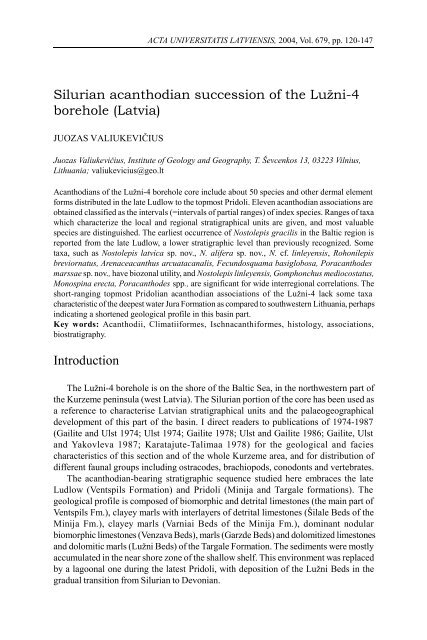Zemes un vides zinātnes Earth and Environment Sciences - Latvijas ...
Zemes un vides zinātnes Earth and Environment Sciences - Latvijas ...
Zemes un vides zinātnes Earth and Environment Sciences - Latvijas ...
You also want an ePaper? Increase the reach of your titles
YUMPU automatically turns print PDFs into web optimized ePapers that Google loves.
ACTA UNIVERSITATIS LATVIENSIS, 2004, Vol. 679, pp. 120-147<br />
Silurian acanthodian succession of the Lužni-4<br />
borehole (Latvia)<br />
JUOZAS VALIUKEVIČIUS<br />
Juozas Valiukevičius, Institute of Geology <strong>and</strong> Geography, T. Ševcenkos 13, 03223 Vilnius,<br />
Lithuania; valiukevicius@geo.lt<br />
Acanthodians of the Lužni-4 borehole core include about 50 species <strong>and</strong> other dermal element<br />
forms distributed in the late Ludlow to the topmost Pridoli. Eleven acanthodian associations are<br />
obtained classified as the intervals (=intervals of partial ranges) of index species. Ranges of taxa<br />
which characterize the local <strong>and</strong> regional stratigraphical <strong>un</strong>its are given, <strong>and</strong> most valuable<br />
species are distinguished. The earliest occurrence of Nostolepis gracilis in the Baltic region is<br />
reported from the late Ludlow, a lower stratigraphic level than previously recognized. Some<br />
taxa, such as Nostolepis latvica sp. nov., N. alifera sp. nov., N. cf. linleyensis, Rohonilepis<br />
breviornatus, Arenaceacanthus arcuatacanalis, Fec<strong>un</strong>dosquama basiglobosa, Poracanthodes<br />
marssae sp. nov., have biozonal utility, <strong>and</strong> Nostolepis linleyensis, Gomphonchus mediocostatus,<br />
Monospina erecta, Poracanthodes spp., are significant for wide interregional correlations. The<br />
short-ranging topmost Pridolian acanthodian associations of the Lužni-4 lack some taxa<br />
characteristic of the deepest water Jura Formation as compared to southwestern Lithuania, perhaps<br />
indicating a shortened geological profile in this basin part.<br />
Key words: Acanthodii, Climatiiformes, Ischnacanthiformes, histology, associations,<br />
biostratigraphy.<br />
Introduction<br />
The Lužni-4 borehole is on the shore of the Baltic Sea, in the northwestern part of<br />
the Kurzeme peninsula (west Latvia). The Silurian portion of the core has been used as<br />
a reference to characterise Latvian stratigraphical <strong>un</strong>its <strong>and</strong> the palaeogeographical<br />
development of this part of the basin. I direct readers to publications of 1974-1987<br />
(Gailite <strong>and</strong> Ulst 1974; Ulst 1974; Gailite 1978; Ulst <strong>and</strong> Gailite 1986; Gailite, Ulst<br />
<strong>and</strong> Yakovleva 1987; Karatajute-Talimaa 1978) for the geological <strong>and</strong> facies<br />
characteristics of this section <strong>and</strong> of the whole Kurzeme area, <strong>and</strong> for distribution of<br />
different fa<strong>un</strong>al groups including ostracodes, brachiopods, conodonts <strong>and</strong> vertebrates.<br />
The acanthodian-bearing stratigraphic sequence studied here embraces the late<br />
Ludlow (Ventspils Formation) <strong>and</strong> Pridoli (Minija <strong>and</strong> Targale formations). The<br />
geological profile is composed of biomorphic <strong>and</strong> detrital limestones (the main part of<br />
Ventspils Fm.), clayey marls with interlayers of detrital limestones (Šilale Beds of the<br />
Minija Fm.), clayey marls (Varniai Beds of the Minija Fm.), dominant nodular<br />
biomorphic limestones (Venzava Beds), marls (Garzde Beds) <strong>and</strong> dolomitized limestones<br />
<strong>and</strong> dolomitic marls (Lužni Beds) of the Targale Formation. The sediments were mostly<br />
accumulated in the near shore zone of the shallow shelf. This environment was replaced<br />
by a lagoonal one during the latest Pridoli, with deposition of the Lužni Beds in the<br />
gradual transition from Silurian to Devonian.
















